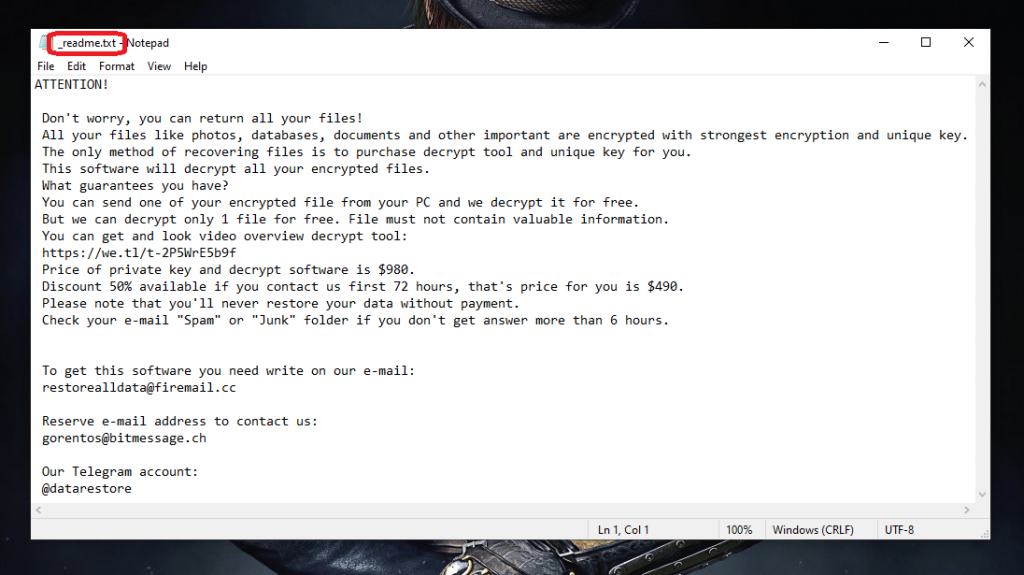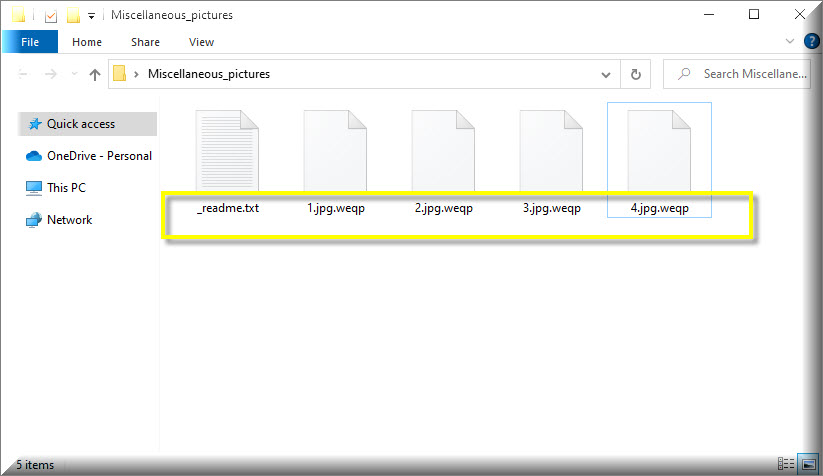*Weqp is a variant of Stop/DJVU. Source of claim SH can remove it.
Weqp
Weqp is a ransomware virus usually used to encode user files and to keep them hostage for a money transfer. In short, Weqp is a malicious program that encrypts your most important information and blackmails you to pay a ransom to decrypt it.

After Weqp has attacked you, a warning message comes out, which lets you know that your files have been encoded and you are required to pay ransom so as to get them back. The next move you can expect from this horrible virus is to set a deadline for the payment and to threaten you that if you don’t pay on time, you will lose access to your encrypted information for good. To be frank, you could rarely find a virus more malicious than a Ransomware-based one. An infection like Weqp, Werz, Weon can be contracted in many ways, but most easily when you carelessly click on infected email messages and attachments, or when interacting with infected pages, compromised web ads and links. Trojans can also deliver a Ransomware in the system without much notice. So, if Weqp has compromised your system, make sure you use a professional removal tool and scan it also for hidden Trojans.
The Weqp virus
The Weqp virus is malicious money-extorting software used by cyber criminals to blackmail web users. The Weqp virus operates by secretly encrypting valuable user files and asking for a ransom payment in exchange for their decryption.
The malware carefully selects which files are of great value for you by scanning all the drives and disks on the infected computer and analyzing which ones you use the most. All these files are then encrypted one by one. At the end of its attack, Weqp creates an awful ransom notification that contains ransom payment demands, payment terms and a few more details on deadlines and how to transfer the money in order to regain access to your information. Sadly, the entire file-encryption attack goes unnoticed in most recorded cases and the victims are faced with the dreadful consequences only thanks to the ransom message that gets generated on their screen.
The .Weqp file decryption
The .Weqp file decryption is an elaborate process that can return the .Weqp encrypted files to their previous state. In order to be performed successfully, however, the .Weqp file decryption typically requires a special decryption key which is traded for a ransom payment.

Usually, most Ransomware viruses can be removed from the system successfully. We can give you instructions on how to remove Weqp in our removal guide below. However, getting your encoded data back is a completely different story. No removal guide, no expert and no software can guarantee that your encrypted data will be safely recovered. To be completely clear, you cannot count on regaining access to your files even if you pay the ransom that the hackers demand. Such criminals violate the law and you can’t expect them to be honest and reliable. They may simply vanish with your money without sending you a decryption key and in this scenario, you will have to say bye-bye both to your money and your files. Therefore, we advise you not to risk your money and suggest that you consider all the alternative steps you can take against these viruses. Consult a specialist, try our removal guide below, explore more alternatives online, or even try to restore files from personal backups.
SUMMARY:
| Name | Weqp |
| Type | Ransomware |
| Danger Level | High (Ransomware is by far the worst threat you can encounter) |
| Data Recovery Tool | Not Available |
| Detection Tool |
*Weqp is a variant of Stop/DJVU. Source of claim SH can remove it.
Remove Weqp Ransomware

To begin, make a note of this page’s URL in your browser’s bookmarks, so that you can return to it easily after completing the next step in the removal guide.
Next, please restart your computer in Safe Mode after you have bookmarked the Weqp removal guide. If you need help with that, see the following URL for step-by-step instructions.

WARNING! READ CAREFULLY BEFORE PROCEEDING!
*Weqp is a variant of Stop/DJVU. Source of claim SH can remove it.
Almost immediately, as the ransomware infection has infiltrated your system, it begins to run a number of dangerous processes in the background. That’s why you must identify and terminate the processes that you believe to be behind Weqp’s behavior.
To do so, press the CTRL, SHIFT, and ESC keys on your keyboard at the same time to bring up the Task Manager. Then, using the Processes tab, scroll through the list of running processes until you come across something suspicious. As seen on the image below, right-click on a possibly dangerous or ransomware-related process and select Open File Location from the context menu that appears:

Once you have completed the above steps, use the free virus scanner offered below to check for any malware in the files associated with that process :

To completely remove any potentially hazardous files discovered by the scanner, you must first stop the corresponding process in Task Manager, which is currently running on your computer. To end a process, right-click it and select “End Process” from the shortcut menu that appears.

Malware such as Weqp has the potential to make changes in the computer’s Hosts file, which can be a common target. In order to check it for unwanted alternations, you must first open your Hosts file, search for any updates under Localhost in the text, and double-check that everything is looking good.
To do so, first open a Run dialog box by pressing the Windows Key and the R key on your keyboard at the same time, then paste the following command into it:
notepad %windir%/system32/Drivers/etc/hosts
Once you select “OK”, the following file should appear on your screen:

Any IP addresses that appear suspicious, such as those in the image above, should be reported to us by leaving a comment below this post. The IP addresses will be checked, and in case there is a danger, you will receive a response from a member of our team with suggestions on what to do.
Then, in the Windows search field (which is normally available in the Start menu), type msconfig and press the Enter key on the keyboard.
The System Configuration window will appear on the screen. Make sure you uncheck any checkmarked Startup items that Weqp has added to the list on the Startup tab. Then, after you’re finished, click OK to close the startup items window.


*Weqp is a variant of Stop/DJVU. Source of claim SH can remove it.
Ransomware infections frequently infiltrate your computer’s Registry, introducing potentially hazardous files in it. Because of this, in order to remove the malware, you must first check the Registry for dangerous files and delete any that are found.
To get to the Registry Editor, type Regedit in the Windows search field and press Enter to open up the program. By pressing Ctrl and F at the same time, you can bring up the Editor’s Find dialog box and type in the name of the ransomware. After that, you can use the Find Next button to run a search to see whether any records exist for that particular name. Following that, you must carefully delete only the entries that are associated with the ransomware.
Attention! In the absence of knowledge on which registry files to erase, an inexperienced user can cause significant damage to the system. To avoid this, it is highly recommended that malware and possibly dangerous files be removed from the system and from the registry only with the help of a profesional anti-malware program.
After you have ensured that the registry is clean, you can manually check for potentially harmful files in the following five locations on your computer. Simply type each of them in the Windows search field, and then hit Enter to open it:
- %AppData%
- %LocalAppData%
- %ProgramData%
- %WinDir%
- %Temp%
In each of them, look for any new files or subfolders with strange-looking names that have been added recently. Remove everything that appears to be out of place as soon as possible. Select and delete all the temporary files that have been saved in Temp in order to remove any malware-created temporary files from the system.

How to Decrypt Weqp files
Victims of ransomware may have a hard time to get their files back, as this process may require a variety of tools and alternative methods in order to effectively decrypt the Ransomware-encrypted data. That’s why if you’ve been infected, the first thing you should do is figure out which ransomware variant has encrypted your data. This can be done if you take a look at the file extensions that have been assigned to the encrypted files.
New Djvu Ransomware
STOP Djvu, is a new Djvu ransomware variant, that is wrecking havoc on any systems that it manages to infect all across the world. All files that have been encrypted by this particular ransomware have the .Weqp extension attached to the end of their filenames. In order to decode STOP Djvu encoded files, these files must be encoded with an offline key, which is currently the only type of key that can be decrypted. To assist you with decrypting your data, we’ve attached a link to a decryption program that you might find useful:
https://www.emsisoft.com/ransomware-decryption-tools/stop-djvu
Using your browser, open the URL above and click the Download button in the top right corner of the page. This will immediately start to download the STOPDjvu.exe file to your computer.
By selecting “run as administrator” and then tapping the Yes button, you will be able to open the file. The decryption process can be started by clicking on the Decrypt button after reading the license agreement and the brief instructions on how to use the program. Please keep in mind that this decryptor does not support files encrypted using unknown offline keys or online encryption, so keep this in mind that this might be the reason if your files cannot be decrypted.
If you cannot deal with the infection manually, please note that you can delete Weqp and other malicious software from your computer with the help of the professional anti-virus tool linked on this page or a powerful online virus scanner. If you have any questions or encounter any difficulties while following this guide, please feel free to ask them in the comments section. We will be happy to help.. If you have any questions or encounter any difficulties while following this guide, please feel free to ask them in the comments section. We will be happy to help.

Leave a Comment